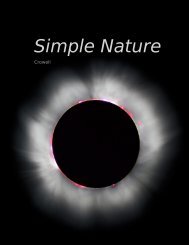Chapter 1 Conservation of Mass - Light and Matter
Chapter 1 Conservation of Mass - Light and Matter
Chapter 1 Conservation of Mass - Light and Matter
You also want an ePaper? Increase the reach of your titles
YUMPU automatically turns print PDFs into web optimized ePapers that Google loves.
f / The gravitational energy<br />
U = −Gm1m2/r graphed as a<br />
function <strong>of</strong> r.<br />
to the mass <strong>of</strong> the object that interacts with the earth gravitationally,<br />
so it makes sense to assume the relationship is symmetric: U is<br />
presumably proportional to the product m1m2. We can no longer<br />
assume ∆U ∝ ∆r, as in the earth’s-surface equation ∆U = mg∆y,<br />
since we are trying to construct an equation that would be valid<br />
for all values <strong>of</strong> r, <strong>and</strong> g depends on r. We can, however, consider<br />
an infinitesimally small change in distance dr, for which we’ll<br />
have dU = m2g1dr, where g1 is the gravitational field created by<br />
m1. (We could just as well have written this as dU = m1g2dr, since<br />
we’re not assuming either mass is “special” or “active.”) Integrating<br />
this equation, we have<br />
�<br />
�<br />
dU = m2g1dr<br />
�<br />
U = m2 g1dr<br />
�<br />
1<br />
U ∝ m1m2 dr<br />
r2 U ∝ − m1m2<br />
,<br />
r<br />
where we’re free to take the constant <strong>of</strong> integration to be equal to<br />
zero, since gravitational energy is never a well-defined quantity in<br />
absolute terms. Writing G for the constant <strong>of</strong> proportionality, we<br />
have the following fundamental description <strong>of</strong> gravitational interactions:<br />
U = − Gm1m2<br />
r<br />
100 <strong>Chapter</strong> 2 <strong>Conservation</strong> <strong>of</strong> Energy<br />
[gravitational energy <strong>of</strong> two masses<br />
separated by a distance r]<br />
We’ll refer to this as Newton’s law <strong>of</strong> gravity, although in reality<br />
he stated it in an entirely different form, which turns out to be<br />
mathematically equivalent to this one.<br />
Let’s interpret his result. First, don’t get hung up on the fact<br />
that it’s negative, since it’s only differences in gravitational energy<br />
that have physical significance. The graph in figure f could be shifted<br />
up or down without having any physical effect. The slope <strong>of</strong> this<br />
graph relates to the strength <strong>of</strong> the gravitational field. For instance,<br />
suppose figure f is a graph <strong>of</strong> the gravitational energy <strong>of</strong> an asteroid<br />
interacting with the sun. If the asteroid drops straight toward the<br />
sun, from A to B, the decrease in gravitational energy is very small,<br />
so it won’t speed up very much during that motion. Points C <strong>and</strong><br />
D, however, are in a region where the graph’s slope is much greater.<br />
As the asteroid moves from C to D, it loses a lot <strong>of</strong> gravitational<br />
energy, <strong>and</strong> therefore speeds up considerably. This is due to the<br />
stronger gravitational field.














